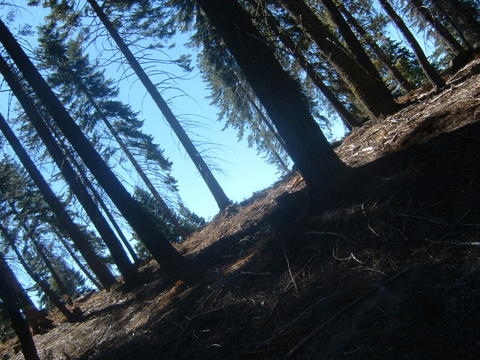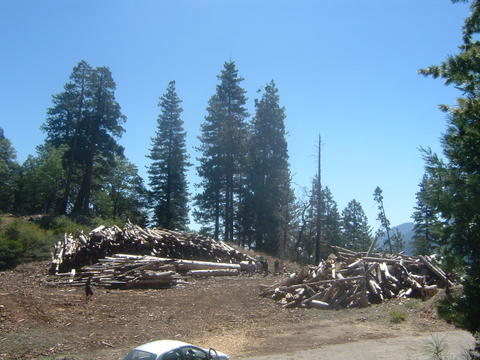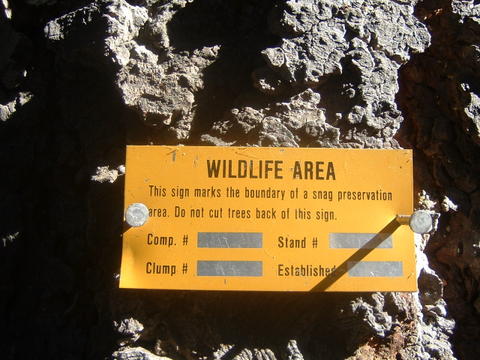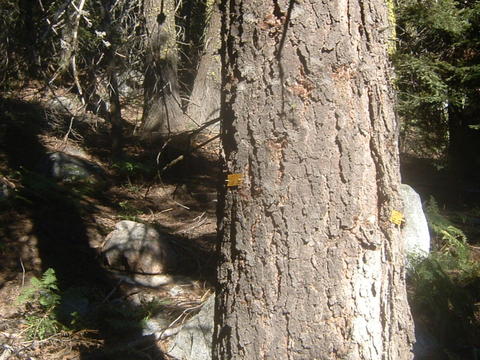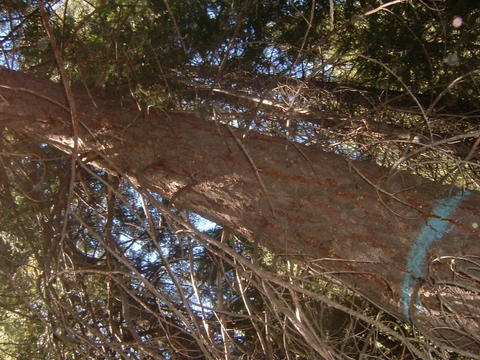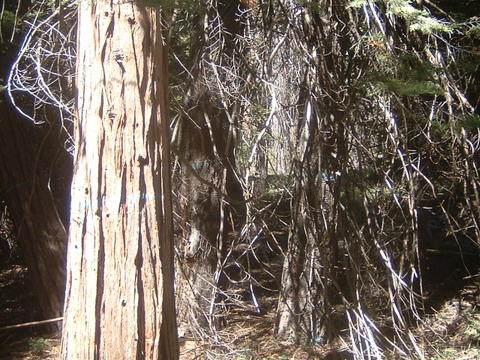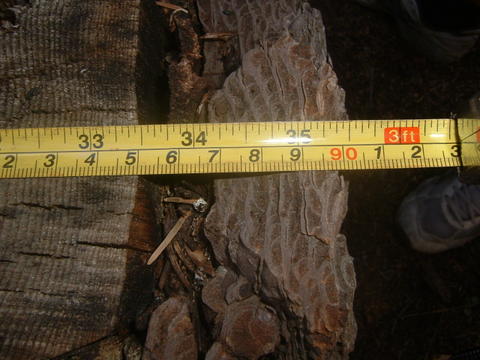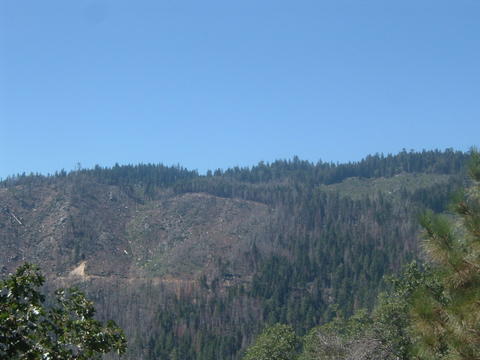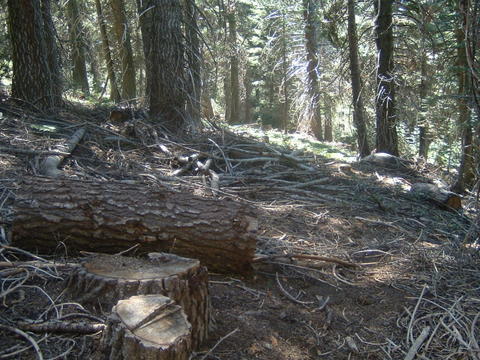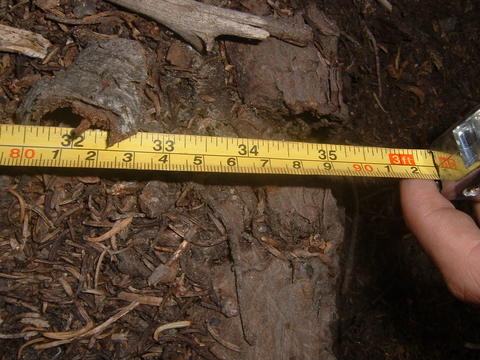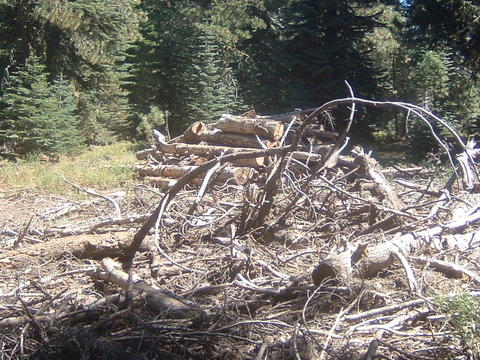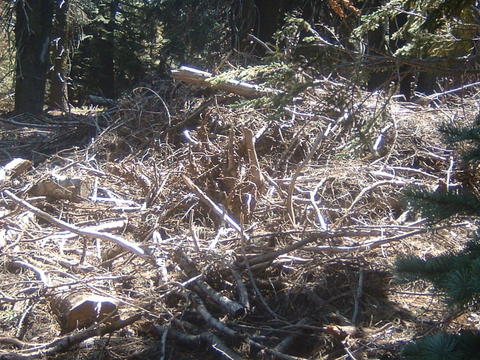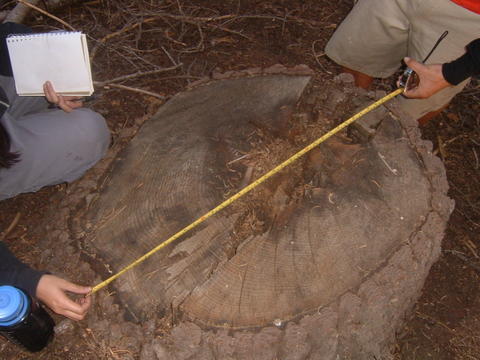From the Open-Publishing Calendar
From the Open-Publishing Newswire
Indybay Feature
Sequoia Revisited
Imagine lying on your back in a thick carpet of pine needles gazing up along the trunk of a majestic, living, breathing, 90 foot tall pine tree. How long has it been a vital part of this forest community? One hundred years? One hundred and fifty years? More? Its tip is waving gently in an azure blue mountain sky. Imagine breathing deeply, savoring the crisp clean air and then reminding yourself—this tree has been marked for death. A jagged line of blue paint circles its bark. Soon it will be gone, like the thousand year old trees that were cut down when this pine was young. Nearly all the old growth is gone, and still we cut. When will we finally say enough? Who will say it? Who will make it stick?
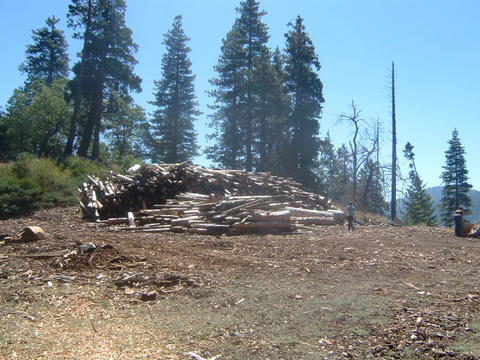
Imagine lying on your back in a thick carpet of pine needles gazing up along the trunk of a majestic, living, breathing, 90 foot tall pine tree. How long has it been a vital part of this forest community? One hundred years? One hundred and fifty years? More? Its tip is waving gently in an azure blue mountain sky. Imagine breathing deeply, savoring the crisp clean air and then reminding yourself—this tree has been marked for death. A jagged line of blue paint circles its bark. Soon it will be gone, like the thousand year old trees that were cut down when this pine was young. Nearly all the old growth is gone, and still we cut. When will we finally say enough? Who will say it? Who will make it stick?
Labor Day weekend consisted of hard slogging forest defense activism for Sierra Nevada Earth First! (http://www.sierranevadaearthfirst.org). A dedicated, and idealistic group of Utopian Tree Pirates from as far away as Los Angeles spent two full days hiking rough terrain and steep slopes, surveying logging units in the Sequoia National Monument, specifically in the Lower White River and Saddle timber sale areas. The monument, established by Bill Clinton in 2000 to protect Sequoia groves and surrounding forests in the southern Sierra Nevada Mountains, has become the latest killing ground for Big Timber and their lackeys in Bush’s US Forest (dis)Service. These sales violate language in the Monument proclamation that specifically prohibits commercial timber cutting. They violate common sense and forest ecology which tell us that all life ultimately depends on the biodiversity of intact ecological systems. And they violate spiritual and aesthetic sensibilities that link us to the power, beauty, majesty, and life of wildlands.
As has become the custom in recent years, the end-run around laws protecting the forest is being made in the name of fuel reduction. Claiming that past forest suppression has led to dangerous fire conditions, the Forest Service has allowed for “mechanical thinning” of trees. This would not necessarily be a problem except that Forest Service guidelines allow for cutting trees up to thirty inches (at breast height—thirty-two inches at the tree’s base) in diameter--that’s 94 inches or nearly 8 feet in circumference. Especially in the arid climate of the southern sierra range, trees of this diameter can be over one hundred years old; they are well established; and they are quite likely to survive even intense fires. Neither these sales nor those planned under Bush’s disgustingly mis-named “Healthy Forest Initiative” have anything to do with forest health or fire reduction. Rather, rules are being developed that clearly deviate from the purpose of the Monument to favor timber interests.
This is bad enough. But what’s worse is that the Forest Service is incapable of applying its own corrupt rules.
In surveying just a tiny fraction of the huge areas slated for logging, activists discovered over fifty instances in which trees or stumps of already cut and killed trees--marked in pale blue paint as legal to be cut by the Forest Service--clearly exceeded the legal guidelines. In case after case, tree base diameters measured 34 to 36 inches. And in numerous instances diameters measured in excess of 40 inches. Add to these measurement errors, significant soil erosion, logging on steep slopes, trenches left by logging trucks and earth movers, huge slash piles that appear to be covering stumps (an illegal practice), and timber cuts and erosion near small streams, and it looks like rules and regulations are for everybody except the Forest Service and the logging companies they love. In one unit activists discovered a small yellow, metal sign pegged into a huge Ponderosa Pine, reading “Wildlife Area: This sign marks the boundary of a snag preservation area. Do not cut back of this sign.” Within thirty feet behind the sign is the familiar sight of a recently cut, blue marked or “legal” tree.
One might contend that these are minor, even if numerous violations. But why, particularly in a National Monument set up to restore forests to their original condition, is the Forest Service erring on the side of the timber industry rather than the forest? Could it be that the director of the Forest Service, Mark Rey, has divided loyalties? After all, the Bush appointee spent twenty years prior to his government job as a lobbyist for Big Timber. He is considered the "key architect" of Sen. Larry Craig's (R-ID) 1997 version of the National Forest Management Act, which would have eliminated citizen oversight and made timber harvest levels mandatory and enforceable, while making environmental standards unenforceable "policies." The Act would have allowed the USFS to fine citizens up to $10,000 for filing appeals to halt timber sales for an "improper purpose." Rey is also widely known as the author of the infamous 1995 Salvage Rider, which suspended all environmental laws, giving logging interests the go-ahead to clearcut ancient forests in the Pacific Northwest. He is a former Vice President of Forest Resources for the American Forest and Paper Association (AF&PA), the leading national voice for more logging in national forests. In this position Rey pushed for getting rid of the USFS appeals process. He is a former Executive Director of the American Forest Resource Alliance, a coalition of 350 timber corporations formed by the National Forest Products Association to oppose "Option 9" - a plan to designate habitat in the Pacific Northwest for the endangered northern spotted owl. He is a former Vice President of Public Forestry Programs for the National Forest Products Association, a precursor to the American Forest and Paper Association. He served as "Environmental Forester;" Director of Water Quality Programs; and Director of Water and Air Quality Programs for the National Forest Products Association/American Paper Institute (information on Rey taken from Native Forests Network, http://www.nativeforest.org). The rules violations discovered by activists are indicative of a Forest Service which serves logging not forests.
Of course, the cumulative effect of these errors by the Forest Service is considerable. But in some instances specific rules violations are massive, and the results are truly devastating. In Unit 601 near Cold Springs Saddle activists found three healthy incense cedar trees marked with blue paint—the death color for trees—that measured over 160 inches in circumference: that’s nearly five feet (60 inches) in diameter, twice the legal limit! The unit had been partially logged, and a light controlled burn had been utilized following the timber cutting. But throughout this steep-sloped area, in the immediate vicinity of the cedars activists discovered something else: fifteen three to four feet deep circular holes in the ground, the holes roughly the same diameter as the base of the remaining cedars. And down inside the holes were the charred remains of what had been huge root masses. How does a light controlled burn which barely singed the forest around, burn out a massive stump and root system? Then activists discovered many more similar sized circles that appeared to have been filled in with dirt and ash. Activists speculate that loggers illegally cut massive trees and then used an accelerant to burn out the stumps thus removing evidence of their unlawful activity. The entire area was a mess of erosion, debris, stumps, holes, and ash. And this is the whole point: the Monument was created to protect forests, not profits. But as long as profit motive remains a factor in decisions regarding the Monument, big trees will continue to fall—whether “legally” or not.
Generally the forests in the southern Sierra are in pathetic shape. One hundred years of relentless logging have left a crazy quilt, mish-mash of conditions. Recent clear cuts marked by uniform stands of young replanted trees stand cheek by jowl with forests cut one hundred years ago and marked to be re-cut today. Some steep sloped areas that have never been cut and contain massive old growth abut flattened areas where logging trucks pick up felled trees. And the whole place is criss-crossed with hundreds of miles of logging roads. Continued cutting in these heavily impacted areas will further undermine any chance for the recovery of threatened and endangered species in the area including the California spotted owl, the northern Goshawk, and the Pacific fisher. Worse, the attitude of domination and assault that is Mark Rey style forest management will continue with further logging. Especially in these times it is precisely such a relationship that must be surmounted by a new, spiritually based connection of people with the natural world of which we are all a part. Care for forests must replace assault on them.
The contrast between these two philosophies is evident in the Museum of Forest Propaganda.
Surveying and other forms of forest defense are a simultaneously exhilarating and depressing experience. Nothing is so revitalizing as hiking, sleeping, eating, and finding fellowship with extraordinary individuals who have dedicated themselves to sparing forests from further destruction. At the same time, the signs of such destruction--past, present, and impending--are everywhere. This Wednesday a federal judge is expected to make a ruling on a current injunction preventing logging in the Saddle Fuels Reduction Project. The (un)Healthy Forest Initiative is, similarly, under review. Whatever the result of these rulings more help will certainly be needed to keep the few fragments of wildlands in the Sierra Nevada mountains intact. If you wish to help please contact Sierra Nevada Earth First! May the forest be with you.
Labor Day weekend consisted of hard slogging forest defense activism for Sierra Nevada Earth First! (http://www.sierranevadaearthfirst.org). A dedicated, and idealistic group of Utopian Tree Pirates from as far away as Los Angeles spent two full days hiking rough terrain and steep slopes, surveying logging units in the Sequoia National Monument, specifically in the Lower White River and Saddle timber sale areas. The monument, established by Bill Clinton in 2000 to protect Sequoia groves and surrounding forests in the southern Sierra Nevada Mountains, has become the latest killing ground for Big Timber and their lackeys in Bush’s US Forest (dis)Service. These sales violate language in the Monument proclamation that specifically prohibits commercial timber cutting. They violate common sense and forest ecology which tell us that all life ultimately depends on the biodiversity of intact ecological systems. And they violate spiritual and aesthetic sensibilities that link us to the power, beauty, majesty, and life of wildlands.
As has become the custom in recent years, the end-run around laws protecting the forest is being made in the name of fuel reduction. Claiming that past forest suppression has led to dangerous fire conditions, the Forest Service has allowed for “mechanical thinning” of trees. This would not necessarily be a problem except that Forest Service guidelines allow for cutting trees up to thirty inches (at breast height—thirty-two inches at the tree’s base) in diameter--that’s 94 inches or nearly 8 feet in circumference. Especially in the arid climate of the southern sierra range, trees of this diameter can be over one hundred years old; they are well established; and they are quite likely to survive even intense fires. Neither these sales nor those planned under Bush’s disgustingly mis-named “Healthy Forest Initiative” have anything to do with forest health or fire reduction. Rather, rules are being developed that clearly deviate from the purpose of the Monument to favor timber interests.
This is bad enough. But what’s worse is that the Forest Service is incapable of applying its own corrupt rules.
In surveying just a tiny fraction of the huge areas slated for logging, activists discovered over fifty instances in which trees or stumps of already cut and killed trees--marked in pale blue paint as legal to be cut by the Forest Service--clearly exceeded the legal guidelines. In case after case, tree base diameters measured 34 to 36 inches. And in numerous instances diameters measured in excess of 40 inches. Add to these measurement errors, significant soil erosion, logging on steep slopes, trenches left by logging trucks and earth movers, huge slash piles that appear to be covering stumps (an illegal practice), and timber cuts and erosion near small streams, and it looks like rules and regulations are for everybody except the Forest Service and the logging companies they love. In one unit activists discovered a small yellow, metal sign pegged into a huge Ponderosa Pine, reading “Wildlife Area: This sign marks the boundary of a snag preservation area. Do not cut back of this sign.” Within thirty feet behind the sign is the familiar sight of a recently cut, blue marked or “legal” tree.
One might contend that these are minor, even if numerous violations. But why, particularly in a National Monument set up to restore forests to their original condition, is the Forest Service erring on the side of the timber industry rather than the forest? Could it be that the director of the Forest Service, Mark Rey, has divided loyalties? After all, the Bush appointee spent twenty years prior to his government job as a lobbyist for Big Timber. He is considered the "key architect" of Sen. Larry Craig's (R-ID) 1997 version of the National Forest Management Act, which would have eliminated citizen oversight and made timber harvest levels mandatory and enforceable, while making environmental standards unenforceable "policies." The Act would have allowed the USFS to fine citizens up to $10,000 for filing appeals to halt timber sales for an "improper purpose." Rey is also widely known as the author of the infamous 1995 Salvage Rider, which suspended all environmental laws, giving logging interests the go-ahead to clearcut ancient forests in the Pacific Northwest. He is a former Vice President of Forest Resources for the American Forest and Paper Association (AF&PA), the leading national voice for more logging in national forests. In this position Rey pushed for getting rid of the USFS appeals process. He is a former Executive Director of the American Forest Resource Alliance, a coalition of 350 timber corporations formed by the National Forest Products Association to oppose "Option 9" - a plan to designate habitat in the Pacific Northwest for the endangered northern spotted owl. He is a former Vice President of Public Forestry Programs for the National Forest Products Association, a precursor to the American Forest and Paper Association. He served as "Environmental Forester;" Director of Water Quality Programs; and Director of Water and Air Quality Programs for the National Forest Products Association/American Paper Institute (information on Rey taken from Native Forests Network, http://www.nativeforest.org). The rules violations discovered by activists are indicative of a Forest Service which serves logging not forests.
Of course, the cumulative effect of these errors by the Forest Service is considerable. But in some instances specific rules violations are massive, and the results are truly devastating. In Unit 601 near Cold Springs Saddle activists found three healthy incense cedar trees marked with blue paint—the death color for trees—that measured over 160 inches in circumference: that’s nearly five feet (60 inches) in diameter, twice the legal limit! The unit had been partially logged, and a light controlled burn had been utilized following the timber cutting. But throughout this steep-sloped area, in the immediate vicinity of the cedars activists discovered something else: fifteen three to four feet deep circular holes in the ground, the holes roughly the same diameter as the base of the remaining cedars. And down inside the holes were the charred remains of what had been huge root masses. How does a light controlled burn which barely singed the forest around, burn out a massive stump and root system? Then activists discovered many more similar sized circles that appeared to have been filled in with dirt and ash. Activists speculate that loggers illegally cut massive trees and then used an accelerant to burn out the stumps thus removing evidence of their unlawful activity. The entire area was a mess of erosion, debris, stumps, holes, and ash. And this is the whole point: the Monument was created to protect forests, not profits. But as long as profit motive remains a factor in decisions regarding the Monument, big trees will continue to fall—whether “legally” or not.
Generally the forests in the southern Sierra are in pathetic shape. One hundred years of relentless logging have left a crazy quilt, mish-mash of conditions. Recent clear cuts marked by uniform stands of young replanted trees stand cheek by jowl with forests cut one hundred years ago and marked to be re-cut today. Some steep sloped areas that have never been cut and contain massive old growth abut flattened areas where logging trucks pick up felled trees. And the whole place is criss-crossed with hundreds of miles of logging roads. Continued cutting in these heavily impacted areas will further undermine any chance for the recovery of threatened and endangered species in the area including the California spotted owl, the northern Goshawk, and the Pacific fisher. Worse, the attitude of domination and assault that is Mark Rey style forest management will continue with further logging. Especially in these times it is precisely such a relationship that must be surmounted by a new, spiritually based connection of people with the natural world of which we are all a part. Care for forests must replace assault on them.
The contrast between these two philosophies is evident in the Museum of Forest Propaganda.
Surveying and other forms of forest defense are a simultaneously exhilarating and depressing experience. Nothing is so revitalizing as hiking, sleeping, eating, and finding fellowship with extraordinary individuals who have dedicated themselves to sparing forests from further destruction. At the same time, the signs of such destruction--past, present, and impending--are everywhere. This Wednesday a federal judge is expected to make a ruling on a current injunction preventing logging in the Saddle Fuels Reduction Project. The (un)Healthy Forest Initiative is, similarly, under review. Whatever the result of these rulings more help will certainly be needed to keep the few fragments of wildlands in the Sierra Nevada mountains intact. If you wish to help please contact Sierra Nevada Earth First! May the forest be with you.
For more information:
http://www.sierranevadaearthfirst.org
Add Your Comments
Latest Comments
Listed below are the latest comments about this post.
These comments are submitted anonymously by website visitors.
TITLE
AUTHOR
DATE
second growth
Fri, Sep 9, 2005 1:19PM
Heck, our second growth is bigger
Thu, Sep 8, 2005 9:03PM
We are 100% volunteer and depend on your participation to sustain our efforts!
Get Involved
If you'd like to help with maintaining or developing the website, contact us.
Publish
Publish your stories and upcoming events on Indybay.
Topics
More
Search Indybay's Archives
Advanced Search
►
▼
IMC Network


